Quincy, MA Pollen and Allergy Report for Summer 2023
Pollen Allergy Trends in Quincy, MA
When is pollen lowest in Quincy, MA?

February
Lowest month total PPM
Avg. PPM
When is pollen highest in Quincy, MA?

April
Highest month total PPM
Avg. PPM
How does pollen in Quincy, MA compare to Massachusetts?
Quincy has a lower average PPM than the state of Massachusetts.
Quincy yearly avg PPM:
Massachusetts yearly avg PPM:
How does pollen in Quincy, MA compare to the USA?
Quincy has a higher average PPM than the USA.
Quincy yearly avg PPM:
USA yearly avg PPM:
Is pollen worse this year in Quincy, MA?
Spring 2023 was worse than spring 2022.
Spring 2023 PPM:
Spring 2022 PPM:
Average PPM in Quincy, MA
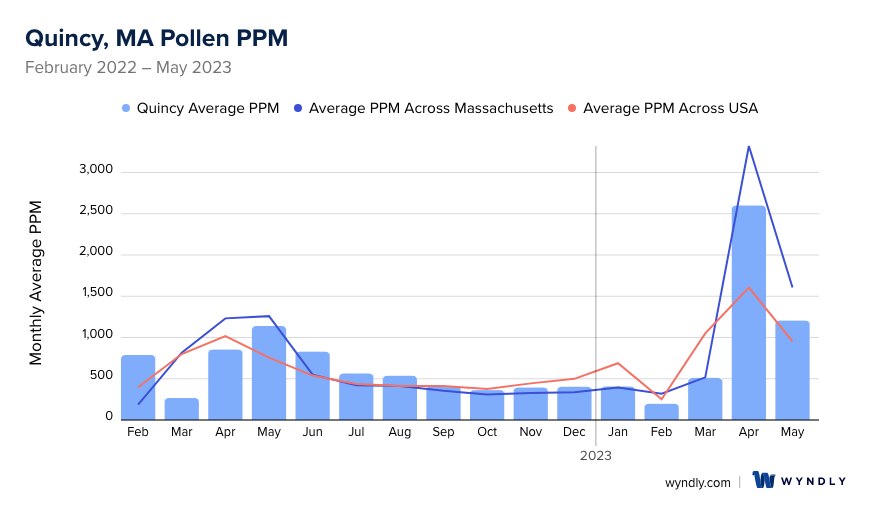
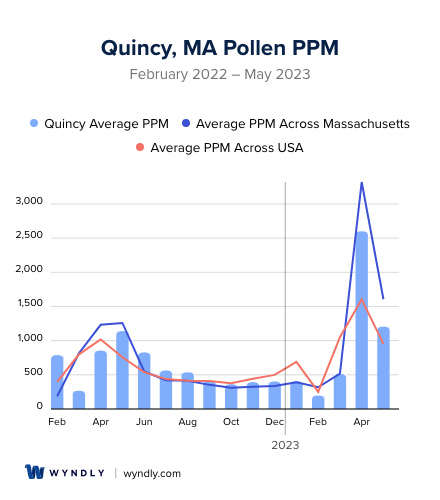
Quincy, MA Pollen and Allergy Breakdown by Month
Grass
When is grass pollen highest in Quincy, MA?
February has the highest grass pollen in Quincy, MA with an average PPM of
When is grass pollen lowest in Quincy, MA?
October has the lowest grass pollen in Quincy, MA with an average PPM of
Tree
When is tree pollen highest in Quincy, MA?
April has the highest tree pollen in Quincy, MA with an average PPM of
When is tree pollen lowest in Quincy, MA?
October has the lowest tree pollen in Quincy, MA with an average PPM of
Weed
When is weed pollen highest in Quincy, MA?
April has the highest weed pollen in Quincy, MA with an average PPM of
When is weed pollen lowest in Quincy, MA?
February has the lowest weed pollen in Quincy, MA with an average PPM of
Quincy, MA Pollen Monthly Breakdown by Pollen Type
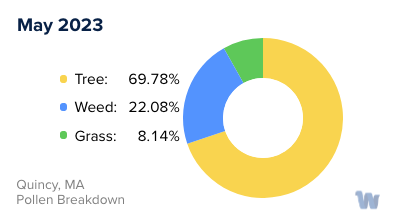
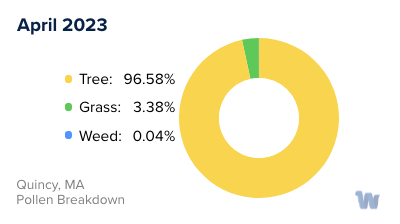
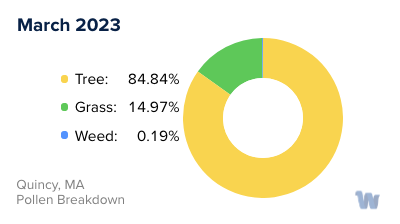
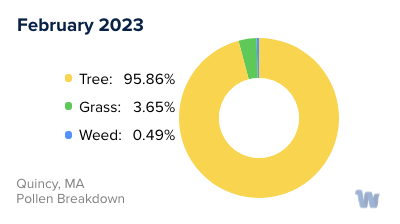
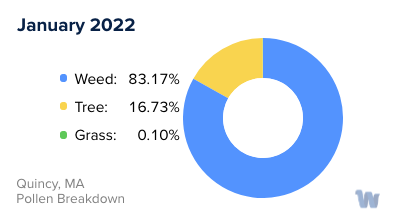
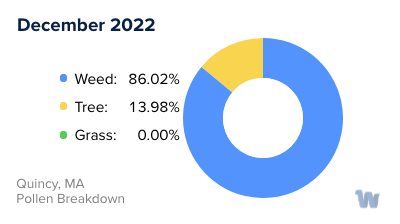
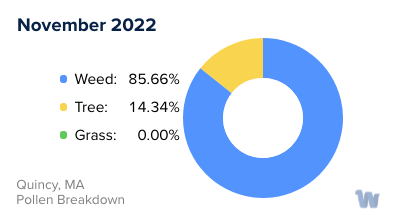
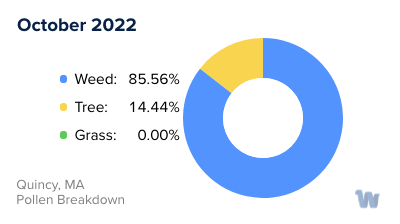
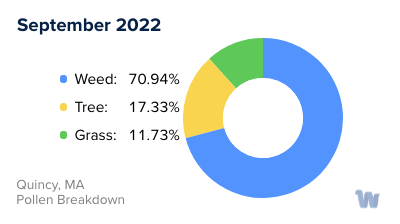
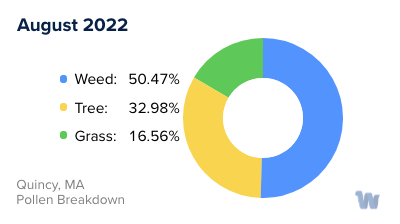
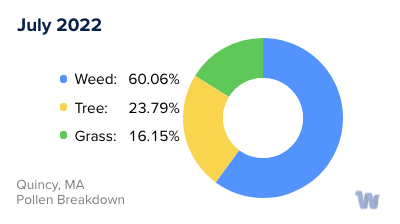
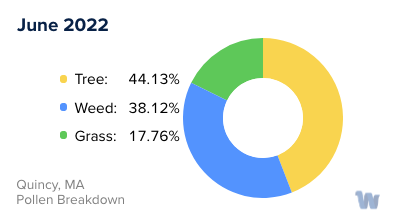
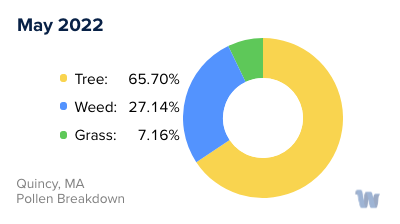
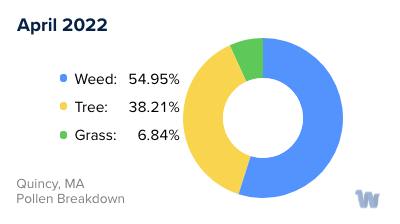
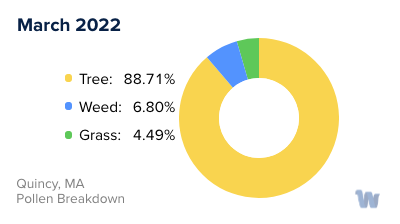
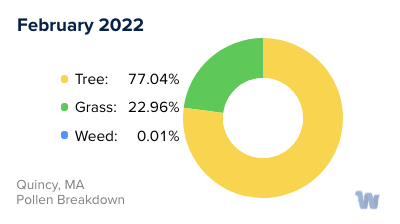
Pollen and Hay Fever in Quincy, MA
Living in the charming city of Quincy, Massachusetts, you might find yourself taken by surprise when spring rolls around. Suddenly, the world is in bloom, and while many of us rejoice at the sight of the emerging flowers and the return of green leaves, those with pollen allergies may brace themselves for the season of sneezing, itching, and watery eyes, otherwise known as hay fever.
In Quincy, a variety of plants release pollen that could trigger allergies. The primary culprits are trees, grasses, and weeds. The types of pollen you'll encounter in Quincy largely depend on the season, and each has its peak period of pollen production.
Spring, with its mild and occasionally rainy weather, is the season when trees start to release their pollen. The most common tree pollens in Quincy include oak, maple, and birch. These trees flourish in our city's parks and neighborhoods, transforming the landscape into a vibrant tableau of colors. Unfortunately, their pollen can trigger hay fever symptoms in sensitive individuals.
As we transition into the warm summer months, grasses take center stage in the pollen production. Timothy grass, Kentucky bluegrass, and ryegrass, commonly found in our city's lawns and fields, start to release their pollen. The bright, sunny days are perfect for these grasses, but they might mean sniffles and sneezes for those with allergies.
When autumn arrives, it’s time for the weeds to make their contribution. Ragweed, a common weed in Quincy, is a major source of pollen in the fall. As the days get shorter and the temperatures cool down, ragweed starts to release its pollen, causing hay fever symptoms to persist for some individuals into the later months of the year.
Understanding the types of pollen and their seasons in Quincy is key to managing pollen allergies. While the blossoming trees, flourishing grasses, and resilient weeds may pose challenges, they also remind us of the natural beauty that surrounds us in our lovely city. Remember, each season brings with it a new type of pollen, and with awareness, we can better navigate our way through the year.

